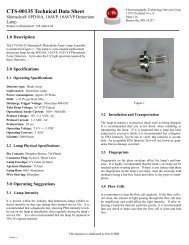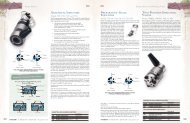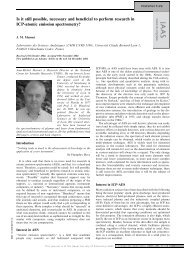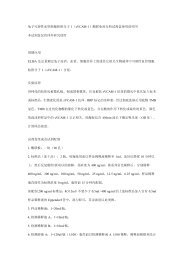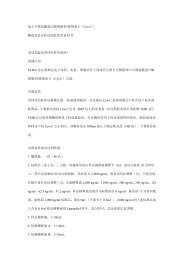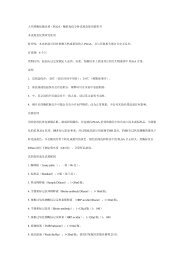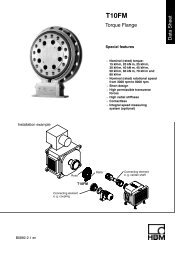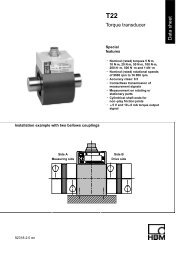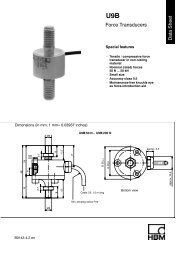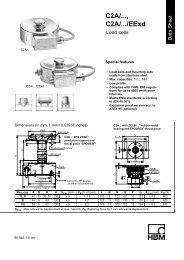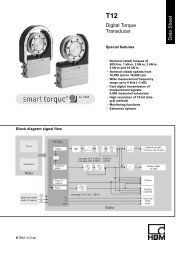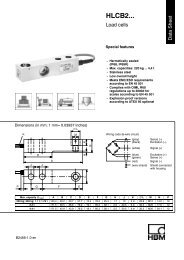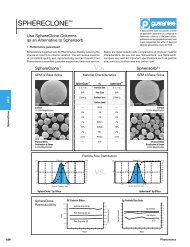Certificate of Analysis
Certificate of Analysis
Certificate of Analysis
You also want an ePaper? Increase the reach of your titles
YUMPU automatically turns print PDFs into web optimized ePapers that Google loves.
National Institute <strong>of</strong> Standards & Technology<br />
<strong>Certificate</strong> <strong>of</strong> <strong>Analysis</strong><br />
Standard Reference Material ® 2569<br />
Lead Paint Films for Children’s Products<br />
This Standard Reference Material (SRM) is intended for use in the evaluation <strong>of</strong> lead in paint on films or similar<br />
matrices using non-destructive, instrumental methods. SRM 2569 consists <strong>of</strong> three different paint films each<br />
containing a specified amount <strong>of</strong> lead (Pb). SRM 2569 is not intended for use in test method calibration for<br />
thickness and density. A unit <strong>of</strong> SRM 2569 consists <strong>of</strong> three coupons <strong>of</strong> paint on polyester and five coupons <strong>of</strong><br />
uncoated polyester. The coupons are approximately 73 mm long by 52 mm wide. The paint films are cured lacquer<br />
having a specified thickness in the range <strong>of</strong> 20 µm to 45 µm.<br />
Certified Values: Certified values for amount <strong>of</strong> Pb as mass fraction in the paint film, mass <strong>of</strong> Pb per unit area <strong>of</strong><br />
paint film, and paint film thickness <strong>of</strong> the three coated components <strong>of</strong> SRM 2569 are reported in Table 1 [1]. Value<br />
assignment categories are based on the definitions <strong>of</strong> terms and modes used at NIST for certification <strong>of</strong> chemical<br />
reference materials [2]. A NIST certified value is a value for which NIST has the highest confidence in its accuracy,<br />
in that all known or suspected sources <strong>of</strong> bias have been investigated or taken into account. A certified value is the<br />
present best estimate <strong>of</strong> the true value based on the results <strong>of</strong> analyses performed at NIST and collaborating<br />
laboratories.<br />
Reference Values: Reference values for paint film density are reported in Table 2. Reference values are<br />
non-certified values that are the best estimates <strong>of</strong> the true values; however, the values do not meet the NIST criteria<br />
for certification and are provided with associated uncertainties that may not include all sources <strong>of</strong> uncertainty [2].<br />
Information Value: An information value for the nominal thickness <strong>of</strong> the polyester sheet supporting the paint<br />
films is reported in Table 3. An information value is considered a value that will be <strong>of</strong> interest to the SRM user, but<br />
insufficient information is available to assess the uncertainty associated with the value.<br />
Expiration <strong>of</strong> Certification: The certification <strong>of</strong> SRM 2569 is valid, within the measurement uncertainty specified,<br />
until 16 August 2021, provided the SRM is handled and stored in accordance with the instructions given in this<br />
certificate (see “Instructions for Handling, Storage, and Use”). The certification is nullified if the SRM is damaged,<br />
contaminated, or otherwise modified.<br />
Maintenance <strong>of</strong> SRM Certification: NIST will monitor this SRM over the period <strong>of</strong> its certification. If<br />
substantive technical changes occur that affect the certification before the expiration <strong>of</strong> the certificate, NIST will<br />
notify the purchaser. Registration (see attached sheet) will facilitate notification.<br />
Coordination <strong>of</strong> the technical measurements for certification <strong>of</strong> SRM 2569 was performed by J.R. Sieber <strong>of</strong> the<br />
NIST Analytical Chemistry Division.<br />
Measurements for homogeneity testing and value assignment <strong>of</strong> SRM 2569 were performed by S.E. Long,<br />
A.F. Marlow, J.L. Molloy, K.E. Murphy, and J.R. Sieber <strong>of</strong> the NIST Analytical Chemistry Division; D. Cobb <strong>of</strong> the<br />
U.S. Consumer Product Safety Commission (CPSC), Rockville, MD, and M. Van de Mark <strong>of</strong> Rolla Coatings,<br />
Rolla, MO. Additional homogeneity measurements were performed by Z. Chen, D. Li and A. Vershinin <strong>of</strong> X-Ray<br />
Optical Systems, East Greenbush, NY and by K. McIntosh at New York State Department <strong>of</strong> Health, Albany, NY.<br />
Statistical consultation for the value assignment <strong>of</strong> SRM 2569 was provided by S.D. Leigh and A.L. Rukhin <strong>of</strong> the<br />
NIST Statistical Engineering Division.<br />
Stephen A. Wise, Chief<br />
Analytical Chemistry Division<br />
Gaithersburg, MD 20899<br />
<strong>Certificate</strong> Issue Date: 21 September 2011<br />
Robert L. Watters, Jr., Chief<br />
Measurement Services Division<br />
SRM 2569 Page 1 <strong>of</strong> 5
Support aspects involved in the issuance <strong>of</strong> this SRM were coordinated through the NIST Measurement Services<br />
Division.<br />
INSTRUCTIONS FOR HANDLING, STORAGE, AND USE<br />
Each coupon <strong>of</strong> SRM 2569 is labeled on the side opposite to the paint coating using a small, self-adhesive label.<br />
The coupon is certified across its entire area; however, measurements must not be made at the area <strong>of</strong> the label. The<br />
coupons are flexible and may be curved to conform to a cylinder ≥1 cm diameter. To use the SRM to simulate<br />
measurement <strong>of</strong> a single layer <strong>of</strong> paint on a plastic substrate, measure the side <strong>of</strong> a coupon opposite to the labeled<br />
side. For determinations <strong>of</strong> Pb, the coupons were designed to provide at least four unique measurement locations for<br />
X-ray spectrometers viewing an area <strong>of</strong> 1 cm 2 . Larger and smaller areas may be measured. The recommended<br />
minimum measurement area is 0.75 mm 2 . Use <strong>of</strong> a viewing area 30 min) to a 3 kW Rh tube source caused damage including substantial blackening and<br />
flaking <strong>of</strong> the paint film.<br />
SRM 2569 Page 2 <strong>of</strong> 5
SOURCE, PREPARATION, AND ANALYSIS (1)<br />
The material for SRM 2569 was created for NIST by Rolla Coatings by applying specially formulated lacquer<br />
compositions to cleaned, uncoated polyester panels (Leneta Corp., Mahwah, NJ, cat. no. P300-7C) using an<br />
automated draw down technique. Lead was added to the lacquer as lead 2-ethylhexanoate. The lacquers also<br />
contain chlorinated dye to impart the green color and to enhance X-ray contrast between the coating and the<br />
polyester substrate. For Level 1 and Level 2 compositions, a chlorinated paraffin wax was added to the lacquers to<br />
further enhance X-ray contrast.<br />
During the characterization <strong>of</strong> paint films and polyester substrate material, elements other than Pb were detected but<br />
not quantified. Elements detected in the uncoated polyester coupons are Na, P, S, Mn, Fe, Cu, Sr, and Sb. Elements<br />
detected in the coated SRM coupons are Na, Al, Si, P, S, Cl, Mn, Fe, Cu, Sr, Sn, and Sb. Of these elements, Cl and<br />
Cu are present in the dye compound used in all three levels, Cl was intentionally added to the lacquer formulations<br />
for Level 1 and Level 2 (see above), and Sb is present as residual catalyst in polyester.<br />
Measurements for homogeneity testing <strong>of</strong> SRM 2569 were performed at NIST using wavelength dispersive X-ray<br />
fluorescence (XRF), multiple monochromatic beam energy dispersive XRF, and microbeam XRF (microXRF).<br />
Additional homogeneity measurements were performed by collaborating laboratories using multiple monochromatic<br />
beam energy dispersive XRF and handheld XRF instrumentation. Measurements for uniformity <strong>of</strong> coating thickness<br />
were made during manufacturing at Rolla Coatings using ultraviolet light absorption spectrometry. The<br />
manufacturer visually inspected all coupons and rejected those containing trapped particles and fibers.<br />
Test Methods Employed at NIST and Collaborating Laboratories: Determinations <strong>of</strong> mass fraction <strong>of</strong> Pb in<br />
paint were performed at NIST using isotope dilution inductively-coupled plasma mass<br />
spectrometry (ID-ICPMS) [3]. Determinations <strong>of</strong> mass <strong>of</strong> Pb per unit area were performed at NIST using XRF.<br />
Independent values <strong>of</strong> mass <strong>of</strong> Pb per unit area were obtained by calculation using ID-ICPMS values <strong>of</strong> Pb mass<br />
fraction, the weighed total mass <strong>of</strong> cured paint per coupon performed by Rolla Coatings, and the mean measured<br />
area <strong>of</strong> a coupon. Measurements <strong>of</strong> thickness were performed at NIST using an outside micrometer gage with the<br />
paint film thickness determined by difference between coated and uncoated coupons. Independent values <strong>of</strong><br />
thickness were calculated from experimentally determined values for paint density performed at NIST, the weighed<br />
total mass <strong>of</strong> cured paint per coupon, and the mean measured area <strong>of</strong> a coupon. Density determinations were<br />
performed at NIST by weighing cured paint films in air and in water and applying Archimedes’ principle <strong>of</strong><br />
buoyancy.<br />
Value Assignments: Each certified value for mass fraction <strong>of</strong> Pb is the mean <strong>of</strong> results obtained at NIST using<br />
ID-ICPMS [3]. For Level 2 and Level 3, the uncertainty listed with each mass fraction is an expanded uncertainty<br />
about the mean with coverage factor k = 2 (approximately 95 % confidence), calculated by combining sources <strong>of</strong><br />
uncertainty characteristic <strong>of</strong> the test method and the material according to the ISO Guide [4]. For Level 1, the<br />
certified value for mass fraction <strong>of</strong> Pb is an upper confidence bound (approximately 99 % confidence) based on the<br />
variance <strong>of</strong> ID-ICPMS results. The certified values for mass <strong>of</strong> Pb per unit area and for paint thickness are the<br />
means <strong>of</strong> sets <strong>of</strong> results obtained using the test methods and calculations listed above. For Level 2 and Level 3, the<br />
uncertainty listed with each value <strong>of</strong> mass <strong>of</strong> Pb per unit area and paint thickness is an expanded uncertainty about<br />
the mean, with coverage factor k = 2 (approximately 95 % confidence), calculated by combining a between-method<br />
variance incorporating differences between methods with a pooled, within-method variance following the ISO<br />
Guide [4]. For Level 1, the certified value for mass <strong>of</strong> Pb per unit area is an upper confidence bound (approximately<br />
99 % confidence) based on the variance <strong>of</strong> NIST XRF results. Each reference value for density <strong>of</strong> paint is the result<br />
obtained at NIST using a gravimetric procedure. The uncertainty listed with each density value is an expanded<br />
uncertainty about the mean with coverage factor k = 2 (approximately 95 % confidence), calculated by combining<br />
sources <strong>of</strong> uncertainty characteristic <strong>of</strong> the test method and the material according to the ISO Guide [4].<br />
(1)<br />
Certain commercial equipment, instruments or materials are identified in this certificate to adequately specify the<br />
experimental procedure. Such identification does not imply recommendation or endorsement by the NIST, nor does it imply that<br />
the materials or equipment identified are necessarily the best available for the purpose.<br />
SRM 2569 Page 3 <strong>of</strong> 5
Table 1. Certified Values for SRM 2569 Lead Paint Films for Children’s Products<br />
Constituent Value Unit<br />
Level 1<br />
Pb Mass Fraction
REFERENCES<br />
[1] Thompson, A.; Taylor, B.N.; Guide for the Use <strong>of</strong> the International System <strong>of</strong> Units (SI); NIST Special<br />
Publication 811; U.S. Government Printing Office: Washington, DC (2008); available at<br />
http://www.nist.gov/pml/pubs/index.cfm/ (accessed Sep 2011).<br />
[2] May, W.; Parris, R.; Beck, C.; Fassett, J.; Greenberg, R.; Guenther, F.; Kramer, G..; Wise, S.; Gills, T.;<br />
Colbert, J.; Gettings, R.; MacDonald, B.; Definitions <strong>of</strong> Terms and Modes Used at NIST for Value-Assignment <strong>of</strong><br />
Reference Materials for Chemical Measurements; NIST Special Publication 260-136; U.S. Government Printing<br />
Office: Washington, DC (2000); available at http://www.nist.gov/srm/publications.cfm (accessed Sep 2011).<br />
[3] Murphy, K.E.; Beary: E.S.; Rearick, M.S.; Vocke, R.D.; Isotope Dilution Inductively Coupled Plasma Mass<br />
Spectrometry (ID ICP-MS) for the Certification <strong>of</strong> Lead and Cadmium in Environmental Standard Reference<br />
Materials; Fres. J Anal. Chem., Vol. 368, pp. 362–370 (2000).<br />
[4] JCGM 100:2008; Evaluation <strong>of</strong> Measurement Data — Guide to the Expression <strong>of</strong> Uncertainty in Measurement<br />
(ISO GUM 1995 with Minor Corrections); Joint Committee for Guides in Metrology (JCGM) (2008); available<br />
at http://www.bipm.org/utils/common/documents/jcgm/JCGM_100_2008_E.pdf (accessed Sep 2011); see also<br />
Taylor, B.N.; Kuyatt, C.E.; Guidelines for Evaluating and Expressing the Uncertainty <strong>of</strong> NIST Measurement<br />
Results; NIST Technical Note 1297; U.S. Government Printing Office: Washington, DC (1994); available at<br />
http://www.nist.gov/pml/pubs/index.cfm (accessed Sep 2011).<br />
[5] Rukhin, A.L.; Weighted Mean Statistics in Interlaboratory Studies; Metrologia, Vol. 46, pp. 323–331 (2009).<br />
[6] DerSimonian, R.; Laird, N.; Meta-analysis in Clinical Trials; Control Clin. Trials, Vol. 7, pp. 177–188 (1986).<br />
[7] Horn, R.A.; Horn, S.A.; Duncan, D.B.; Estimating Heteroscedastic Variance in Linear Models; J. Am. Stat.<br />
Assoc., Vol. 70, pp. 380–385 (1975).<br />
Users <strong>of</strong> this SRM should ensure that the <strong>Certificate</strong> <strong>of</strong> <strong>Analysis</strong> in their possession is current. This can be<br />
accomplished by contacting the SRM Program: telephone (301) 975-2200; fax (301) 926-4751;<br />
e-mail srminfo@nist.gov; or via the Internet at http://www.nist.gov/srm.<br />
SRM 2569 Page 5 <strong>of</strong> 5



